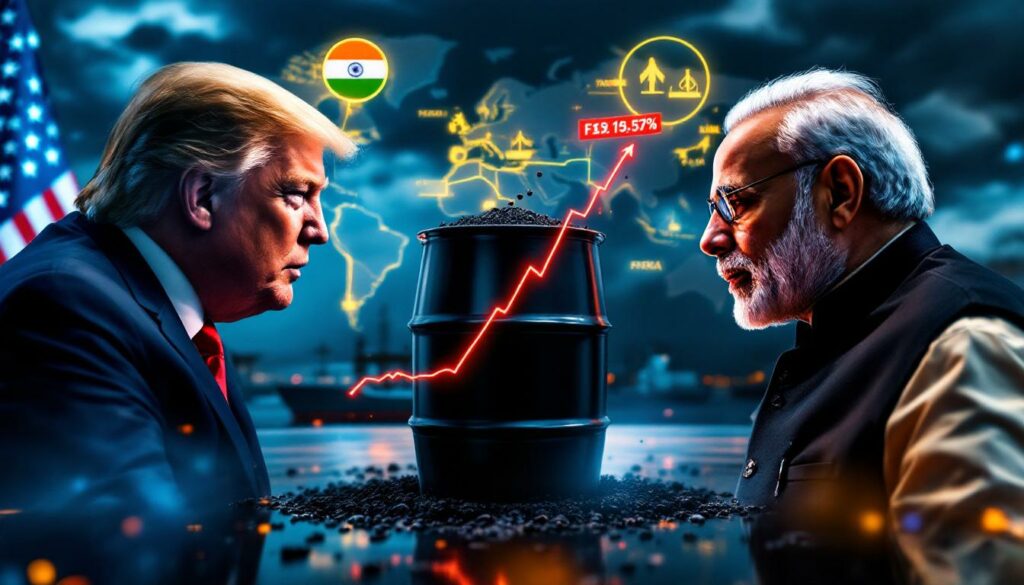Understanding Trump's Tariff Strategy Against India
President Trump has significantly escalated pressure on countries purchasing Russian oil, with India becoming a primary target in his broader economic strategy to isolate Russia. This policy shift represents a dramatic change in U.S.-India relations and signals Trump's willingness to use economic leverage against even strategic partners to achieve geopolitical objectives.
What Prompted Trump's Targeting of India's Oil Trade?
The administration's focus on India stems from the country's substantial increase in Russian oil purchases since 2022. Trump has drastically shortened the timeline for Russia to reach a peace agreement with Ukraine from 50 days to just 10-12 days, representing an 80% reduction in the diplomatic window. This aggressive timeline comes with a serious threat—secondary tariffs of up to 100% on countries continuing to import Russian oil if no progress is made on Ukraine peace negotiations.
"Concerns that secondary tariffs on countries importing Russian crude will tighten supplies continue to drive buying interest," noted Toshitaka Tazawa of Fujitomi Securities, highlighting the market's immediate reaction to these threats.
The administration's approach appears calculated to target India specifically because of its democratic governance (potentially making it more responsive to pressure than authoritarian states) and its valuable broader trade relationship with the U.S. that creates meaningful economic leverage.
How Are the Tariffs Being Implemented?
The White House has confirmed that 25% tariffs on Indian imports will take effect immediately, despite ongoing trade negotiations between the two nations. These tariffs rely on a combination of executive orders and Treasury Department authorities, though the legal framework supporting secondary sanctions remains complex.
The implementation timing appears strategic, coming as India has become increasingly dependent on discounted Russian crude. By targeting a strategic partner rather than an adversary, the administration is demonstrating the global reach of its sanctions policy and testing the effectiveness of economic pressure on allies.
The Scope of India's Russian Oil Imports
Since Western sanctions were imposed following the Ukraine conflict, India has transformed into one of Russia's largest oil customers. Indian refiners have capitalized on steep discounts, sometimes exceeding $30 per barrel, allowing them to process Russian crude into refined products for both domestic consumption and international export.
This trade relationship has provided India with significant economic advantages while helping Russia maintain critical oil revenue streams despite Western sanctions. The volume of Russian oil flowing to India increased nearly tenfold in the two years following the Ukraine conflict, creating a lucrative energy partnership that the Trump trade war effects now aims to disrupt.
Global Oil Market Impacts and Price Movements
The tariff threats have sent immediate shockwaves through global energy markets, triggering significant price volatility and reshaping trading patterns as market participants adjust to this new geopolitical reality.
Oil Price Responses to Trump's Actions
Oil markets have reacted strongly to the escalating trade tensions, with both WTI and Brent crude experiencing approximately 7% price increases in a single week. WTI crude reached $69.99 per barrel while Brent traded at $73.10, reflecting market concerns about potential supply constraints resulting from disrupted Russian oil flows.
This price movement indicates traders are pricing in significant geopolitical risk premiums. The speed of the price increase suggests markets were caught somewhat unprepared for the aggressive timeline Trump established for Russian compliance, creating a rapid repricing of risk across global energy markets.
Emerging Trading Patterns
The uncertainty surrounding Russian oil flows has created notable shifts in market dynamics. The Brent-Dubai spread has moved deeper into discount territory as Asian refiners look to Middle Eastern suppliers for more secure alternatives to Russian crude. This price relationship serves as a key indicator of changing trade flows, with widening spreads typically signaling increased competition for non-Russian barrels.
Market participants are closely monitoring shipping data and trade flows for early indications of India's compliance with the pressure campaign. The reconfiguration of global oil trade routes could create logistical bottlenecks and regional price disparities as the market adjusts to new supply patterns.
Inventory Levels and Market Sentiment
Recent EIA data revealed a 7.7 million barrel build in U.S. crude inventories for the week ending July 25, bringing stockpiles to 426.7 million barrels. This unexpected increase was primarily attributed to a sharp 1.16 million barrel per day drop in exports.
Despite this bearish signal, gasoline inventories fell by 2.7 million barrels, far exceeding analyst expectations and suggesting robust summer driving demand remains intact. Meanwhile, distillate stocks rose by 3.64 million barrels, creating a complex inventory picture that provides some counterbalance to the crude build.
This mixed inventory data reflects the current market uncertainty, with traders balancing immediate geopolitical concerns against underlying supply-demand fundamentals that remain relatively balanced. The oil price movements continue to reflect these complex market dynamics.
Indian Refiners' Response to Tariff Pressures
The tariff threats have forced Indian refiners to make rapid operational adjustments while navigating complex financial calculations about the continuing viability of Russian crude purchases.
Refinery Operational Adjustments
Reports indicate that several major Indian refiners have paused new procurement of Russian crude while they assess the implications of Trump's tariff threats. This operational adjustment represents a significant shift after months of aggressive Russian oil purchasing.
Refiners are now exploring alternative supply sources from the Middle East and West Africa to ensure operational continuity while minimizing exposure to potential secondary sanctions. This sudden shift in procurement strategies has created logistical challenges as refiners must secure new supply contracts on compressed timelines.
Financial Challenges for Indian Refiners
Indian refiners now confront a complex financial calculation. The economic advantage of discounted Russian crude must be weighed against the potential cost of U.S. tariffs on refined product exports and broader trade relationships.
Additionally, refiners face potential banking and insurance complications as financial institutions grow increasingly cautious about facilitating transactions involving Russian oil, even indirectly. The risk of being caught in the secondary sanctions net has raised compliance costs and created additional uncertainty in financial planning.
Potential Domestic Fuel Market Effects
Any significant reduction in Russian oil imports could impact India's domestic fuel pricing structure. The discounted Russian crude has helped Indian refiners maintain profitability while keeping domestic fuel prices relatively stable despite global market volatility.
If refiners are forced to switch to higher-priced alternatives, this could eventually translate to increased prices at Indian fuel pumps, creating potential economic and political challenges domestically. The Indian government may face difficult choices between complying with U.S. pressure and managing domestic energy affordability concerns.
Broader Geopolitical Implications
The tariff confrontation extends far beyond energy markets, introducing significant complications into global diplomatic relationships and potentially accelerating changes in the international order.
U.S.-India Strategic Relations
The tariff confrontation introduces significant tension into the U.S.-India strategic partnership, which has been strengthened in recent years partly as a counterbalance to China's regional influence. India's government must now navigate competing priorities: maintaining economic sovereignty and beneficial Russian trade relationships while preserving its crucial strategic alignment with the United States.
This balancing act represents one of the most challenging diplomatic tests for bilateral relations in recent years. The situation is further complicated by India's historical policy of strategic autonomy and its reluctance to align completely with any single global power.
China's Position in the Evolving Situation
China, as the top buyer of both Russian and Iranian oil, faces similar pressure from the Trump administration. On Wednesday, the U.S. unveiled new sanctions targeting more than 115 Iran-linked individuals, companies, and ships as part of an escalation of the "maximum pressure" campaign following airstrikes on Iranian nuclear sites in June, according to reports from The Guardian.
Unlike India, China has more economic leverage and may be less susceptible to U.S. pressure tactics. The situation creates potential for closer Russia-China-India energy cooperation as these nations potentially seek to create alternative payment mechanisms and trade structures that minimize U.S. dollar dependency.
Reshaping Global Oil Trade Patterns
The targeting of India could accelerate the fragmentation of global oil markets into distinct trading blocs. If Russian oil becomes increasingly difficult to trade openly, we may see the emergence of parallel market structures with different pricing mechanisms, payment systems, and shipping arrangements.
This fragmentation could fundamentally alter decades-old patterns of global oil trade and price discovery mechanisms. The potential development of alternative financial systems for oil trade could have long-lasting implications for the dollar's role in global energy markets, as highlighted in recent US-China trade war analysis.
Economic Consequences Beyond Oil Markets
The economic ripple effects of this trade confrontation extend well beyond energy markets, potentially impacting global trade patterns, currency markets, and inflation dynamics.
Broader Trade Impacts
The oil-focused tariffs could trigger wider trade disruptions between the U.S. and India across multiple sectors. India's technology, pharmaceutical, and textile exports to the U.S. could face challenges if the dispute escalates.
Similarly, U.S. defense sales to India, which have grown significantly in recent years, might be jeopardized if diplomatic relations deteriorate further. The interconnected nature of modern global supply chains means that disruptions in one sector often cascade into others, potentially creating broader economic friction.
Currency Market Responses
The Indian rupee has already shown signs of volatility in response to the tariff announcements. Further pressure could emerge if India's balance of payments position deteriorates due to higher oil import costs combined with reduced export opportunities to the U.S. market.
Currency volatility would create additional challenges for Indian businesses engaged in international trade and potentially accelerate inflation pressures. The rupee's movements will serve as an important indicator of market confidence in India's ability to navigate this diplomatic challenge.
Potential Impacts on Global Inflation
If the tariff strategy successfully constrains Russian oil flows and drives global oil prices higher, this could contribute to inflationary pressures worldwide. Coming at a time when central banks are still navigating post-pandemic monetary policy normalization, higher energy costs could complicate inflation management.
This potential inflationary pressure might necessitate more aggressive interest rate policies, with implications for economic growth across developed and emerging markets alike. The timing is particularly challenging as many economies are still working to achieve sustainable post-pandemic growth trajectories. As analysts examine the tariffs impact on markets, the inflation risk remains a key concern.
Future Scenarios and Market Outlook
The evolving situation presents several potential pathways forward, with significant implications for global energy markets, geopolitical relationships, and economic stability.
Will India Maintain Russian Oil Purchases Despite Pressure?
The most likely scenario involves India reducing but not eliminating Russian oil purchases while seeking diplomatic compromise with the U.S. Complete abandonment of Russian oil would be economically costly for India, while complete defiance of U.S. pressure would risk broader strategic relationships.
A calibrated reduction combined with diplomatic engagement represents the most pragmatic path forward for Indian policymakers. This approach would allow India to demonstrate responsiveness to U.S. concerns while preserving some degree of economic benefit and policy autonomy.
Russia's Potential Responses to Shrinking Export Markets
Russia faces significant challenges if major buyers like India reduce purchases. With limited pipeline infrastructure to redirect flows and a shrinking pool of willing buyers, Russia might be forced to cut production or offer even steeper discounts to maintain market share.
Either scenario would further strain Russia's energy-dependent economy and potentially increase domestic economic pressures. The effectiveness of Trump's strategy depends partly on Russia's ability to find alternative markets and maintain revenue streams despite increasing international isolation.
Key Indicators for Market Participants to Monitor
Market participants should closely track several key indicators to anticipate future developments. These include:
- Changes in tanker tracking data showing Russian export destinations
- Shifts in price differentials between Russian grades and global benchmarks
- Diplomatic statements from Indian officials regarding energy policy
- Refined product flows from India to international markets
- Currency movements, particularly the Indian rupee
- U.S.-India diplomatic engagements and potential compromise frameworks
These indicators will provide early signals about the effectiveness of the pressure campaign and potential market adjustments.
FAQ: Trump's Targeting of India Over Russian Oil
Why is Trump specifically targeting India among all Russian oil buyers?
India represents a strategic target due to its significant increase in Russian oil purchases since 2022, its democratic governance making it potentially more responsive to pressure than authoritarian states, and its valuable broader trade relationship with the U.S. that creates meaningful economic leverage.
Additionally, successfully pressuring India would demonstrate the effectiveness of the administration's sanctions strategy and potentially encourage compliance from other nations. India's strategic importance as a counterbalance to China in the Indo-Pacific region also gives the U.S. significant incentive to bring India's energy policy into closer alignment with Western objectives.
Could these tariffs lead to global oil supply shortages?
While immediate physical shortages are unlikely given current global spare production capacity, the tariffs could create significant regional imbalances and logistical challenges as trade flows reorganize. The greater risk comes from potential price volatility as markets adjust to new trading patterns and uncertainty about future policy directions.
Strategic reserves could be deployed if serious supply disruptions emerge, but the primary market impact will likely be price-based rather than physical shortage-based. The timing of any potential disruptions would be particularly important given seasonal demand patterns and existing inventory levels.
How might this affect U.S. domestic energy policy?
The administration has suggested that U.S. domestic production could increase to offset any global supply disruptions resulting from constrained Russian exports. However, industry analysts question whether U.S. producers can rapidly scale up production given current capital discipline, labor constraints, and equipment limitations.
This tension highlights the complex relationship between foreign policy objectives and domestic energy realities. The administration may need to balance sanctions enforcement with energy price stability considerations, potentially leading to a more nuanced implementation approach than initially indicated. The potential impacts on U.S. tariffs and inflation remain a significant concern among economists.
What legal mechanisms support secondary sanctions on Russian oil buyers?
The implementation of secondary sanctions relies on a combination of executive orders, Treasury Department authorities, and existing legislation regarding sanctions enforcement. While legal challenges may emerge, particularly from affected international entities, U.S. courts have historically granted significant deference to the executive branch in matters of foreign policy and national security.
This legal framework gives the administration substantial flexibility in implementation, though diplomatic considerations may ultimately prove more constraining than legal limitations. The effectiveness of secondary sanctions depends largely on the willingness of international financial institutions to comply with U.S. directives, given their exposure to the U.S. financial system, according to analysis from ABC News.
Disclaimer: This analysis contains market forecasts and geopolitical assessments that are subject to uncertainty and change as events develop. Readers should conduct their own research and consult with appropriate financial and legal advisors before making investment or business decisions based on this information.
Ready to Stay Ahead of Major Market Movements?
Discovery Alert's proprietary Discovery IQ model identifies significant ASX mineral discoveries instantly, turning complex data into actionable trading opportunities. Explore how historic discoveries have generated substantial returns by visiting our dedicated discoveries page and begin your 30-day free trial today.




